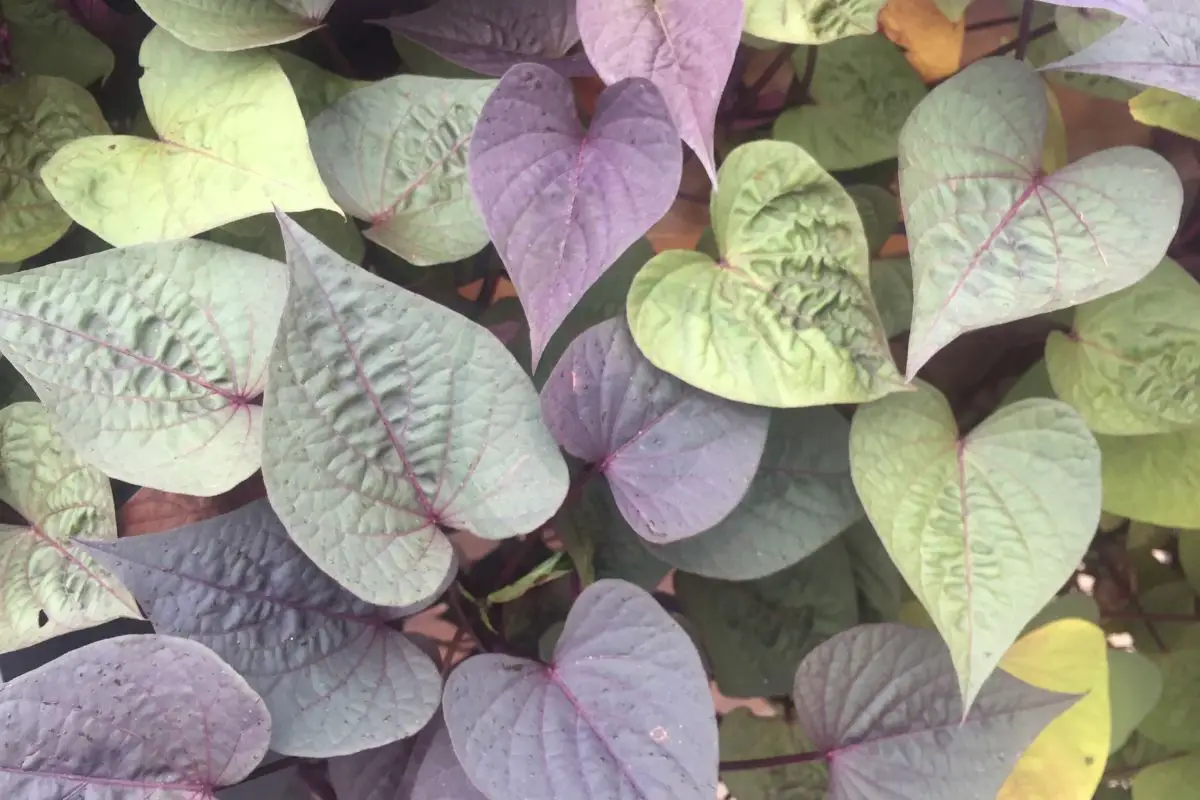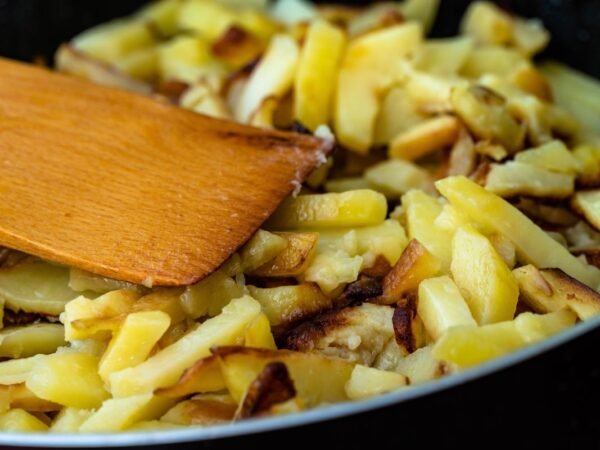Looking to start Purple Sweet Potato planting? You're in the right place! As an expert in agriculture and gardening, I can guide you through the process step by step to ensure successful cultivation of these vibrant tubers.
To plant purple sweet potatoes successfully, follow these steps:
- Choose a sunny location with well-drained, loose soil.
- Prepare the soil by loosening it to a depth of at least 12 inches and incorporating organic matter.
- Plant the sweet potato slips or cuttings in rows, spacing them about 12 inches apart.
- Water the plants regularly, keeping the soil consistently moist but not waterlogged.
- Fertilize the plants with a balanced fertilizer every 4-6 weeks.
- Control weeds by mulching around the plants and hand-weeding as needed.
- Monitor for pests and diseases, and take appropriate measures to control them.
- Harvest the sweet potatoes when the foliage starts to yellow and die back, typically around 3-4 months after planting.
With these simple steps, you can enjoy a bountiful harvest of nutritious and delicious purple sweet potatoes. Happy planting!
Ready to delve deeper into the world of purple sweet potato cultivation? Stay tuned for more expert tips, tricks, and insights on maximizing your yield and enhancing the health of your plants. Whether you're a novice gardener or an experienced farmer, there's always more to learn and explore in the realm of agriculture.
Key Takeaways
- Start Planting: Begin by understanding purple sweet potatoes and preparing for planting to ensure a successful harvest.
- Create Potato Slips: Engage in a DIY project to create potato slips, a crucial step in the planting process.
- Plant with Care: Follow the proper planting process to give your sweet potatoes the best chance to thrive.
- Provide Proper Care: Regularly care for your plants by watering, fertilizing, and monitoring for pests or diseases.
- Harvest Thoughtfully: Harvest sweet potatoes when they are mature, and handle them carefully to avoid damage.
- Store and Cook: After harvesting, cure and store sweet potatoes correctly for long-lasting freshness, then explore various cooking methods and recipes.
Understanding Purple Sweet Potatoes
Nutritional Benefits
Purple sweet potatoes, also known as Okinawan sweet potatoes, are packed with rich nutrients. They contain high levels of anthocyanin and polyphenols, offering various health benefits. These compounds act as powerful antioxidants, promoting overall well-being. Moreover, purple sweet potatoes are free from saturated fats and cholesterol, making them a healthy choice for your diet.
Taste Profile
Okinawan sweet potatoes boast a distinctive taste profile with a nutty and slightly earthy flavor. When compared to orange sweet potatoes, purple sweet potatoes have a unique sweetness level that sets them apart. The vibrant magenta interior color of purple sweet potatoes remains striking even after cooking.
Preparing for Planting
Soil Preparation
Sweet potatoes thrive in light, fluffy soil that drains well, ensuring healthy root development and preventing waterlogging. Enriching the soil with compost boosts nutrient levels, promoting robust growth and high yields. To create ideal conditions, loosen the ground to a depth of 12 inches and mix in compost.
Planting Schedule
Plant sweet potato slips only when temperatures consistently exceed 50°F, as these plants are sensitive to cold. Timing is crucial for successful growth, ensuring optimal conditions for vine development and tuber formation. Ordering slips early is recommended to avoid delays caused by cold weather.
Space Requirements
For efficient growth, plant sweet potato slips 12 to 18 inches apart to allow ample space for each plant's vines to spread. Sweet potatoes develop beneath the plant's crown in clusters, requiring sufficient room for expansion. Adequate spacing between plants is essential for maximizing overall production.
DIY Potato Slips
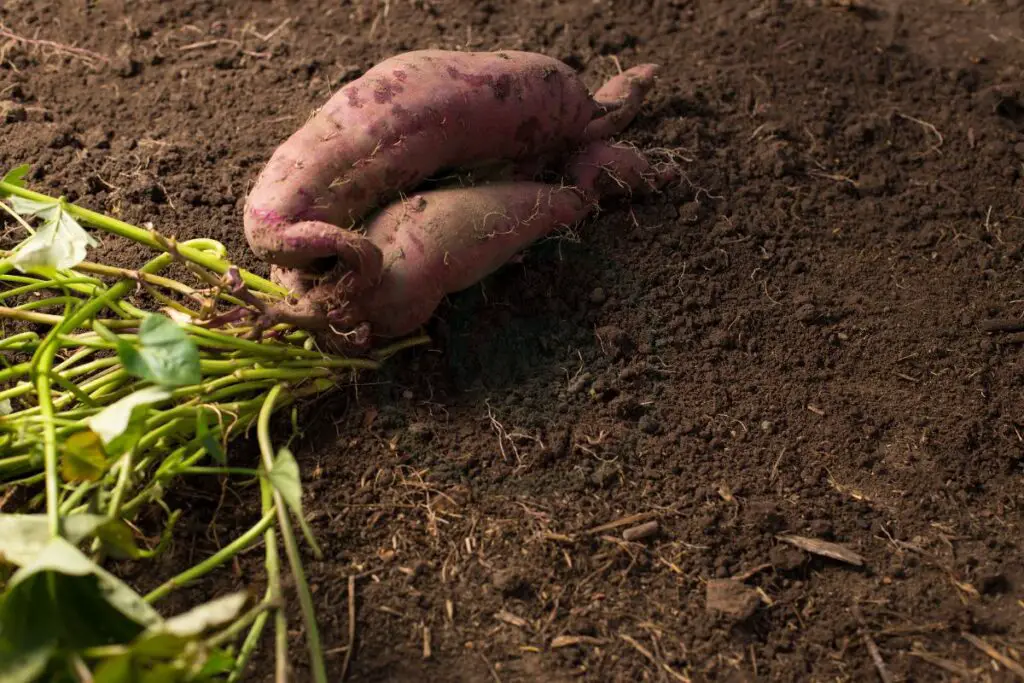
Starting Slips
Cutting Techniques
To create sweet potato slips for planting, cut a mature sweet potato into sections containing at least one eye. Handle the slips carefully to avoid damage. Ensuring the slips are healthy is crucial for successful growth.
Rooting Process
The rooting process of sweet potato slips involves burying them in loose, well-draining soil. Roots develop from the nodes on the slip, anchoring it in the soil. Monitoring moisture levels and providing support aids in successful rooting.
Tips for Success
- Sweet potatoes thrive in loose, well-drained soil.
- Low maintenance requirements make sweet potatoes ideal for beginner gardeners.
- Proper spacing, adequate sunlight, and regular watering contribute to a bountiful harvest.
Planting Process
Successful Planting Tips
Plant purple sweet potato slips in well-draining soil to prevent waterlogging and root rot. Ensure the planting depth is around 3 inches to promote strong root development. Water consistently but avoid over-saturation to prevent fungal diseases. Provide adequate sunlight for at least 6-8 hours daily for optimal growth.
To ensure successful growth, fertilize the plants with a balanced fertilizer high in potassium. Mulch around the plants to retain moisture and suppress weeds. Regularly check for pests like aphids and caterpillars, removing them promptly to prevent damage.
Following proper planting guidelines is crucial for success. Avoid overcrowding by planting slips at least 12 inches apart. Monitor soil moisture levels regularly and adjust watering frequency based on weather conditions. Harvest sweet potatoes when leaves start turning yellow for best results.
Protecting Leaves
Protect sweet potato leaves from damage by avoiding excessive handling, which can lead to bruising and tearing. Be gentle when tending to the plants to prevent stress that can impede growth. Inspect leaves regularly for signs of pests or diseases.
Healthy leaves are essential for sweet potato growth as they are responsible for photosynthesis, converting sunlight into energy for the plant. To maintain leaf health, water at the base of the plant to avoid wetting the foliage, which can promote fungal infections. Consider using organic pesticides if pest infestations occur.
Throughout the growing season, monitor leaf color and texture as indicators of plant health. Yellowing or wilting leaves may signal nutrient deficiencies or overwatering issues. Prune damaged or diseased leaves promptly to prevent spread and promote overall plant vigor.
Caring for Plants
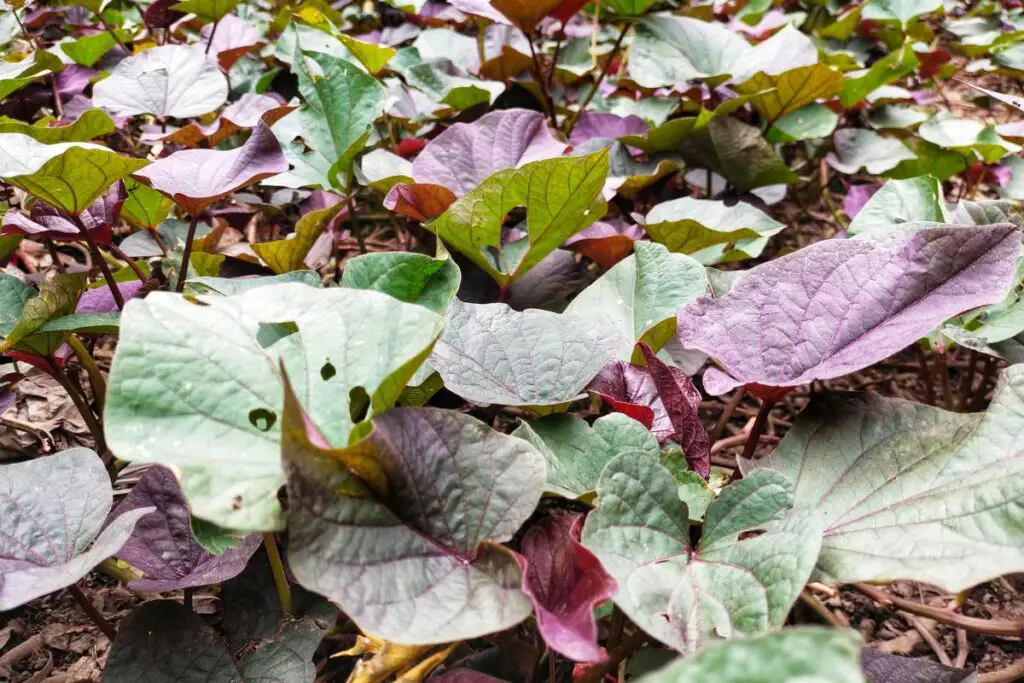
Watering Needs
Sweet potatoes require consistent moisture levels for optimal growth. Ensure the soil remains damp but not waterlogged to prevent rot. Water deeply once a week, adjusting based on weather conditions to maintain moisture balance.
To support sweet potato development, water plants regularly during dry spells. Avoid overwatering as it can lead to fungal diseases. Mulching around plants helps retain moisture and regulate soil temperature.
Sunlight Exposure
Adequate sunlight is crucial for sweet potato plants to thrive. Position them in an area that receives at least 6-8 hours of sunlight daily. Insufficient sunlight can result in stunted growth and poor tuber formation.
Place sweet potato containers or garden beds in a spot with full sun exposure. Consider using trellises or stakes to ensure vines receive ample sunlight for photosynthesis. Regularly rotate containers to promote even light distribution.
Pest Management
Common pests that affect sweet potato plants include aphids, flea beetles, and sweet potato weevils. Monitor plants regularly for signs of infestation such as yellowing leaves or holes in foliage. Introduce beneficial insects like ladybugs to control pest populations naturally.
Prevent pest infestations by practicing good garden hygiene and removing plant debris promptly. Implement physical barriers like row covers to protect young plants from pests. Neem oil sprays and insecticidal soaps are effective organic solutions for controlling pests on sweet potatoes.
Harvesting Sweet Potatoes
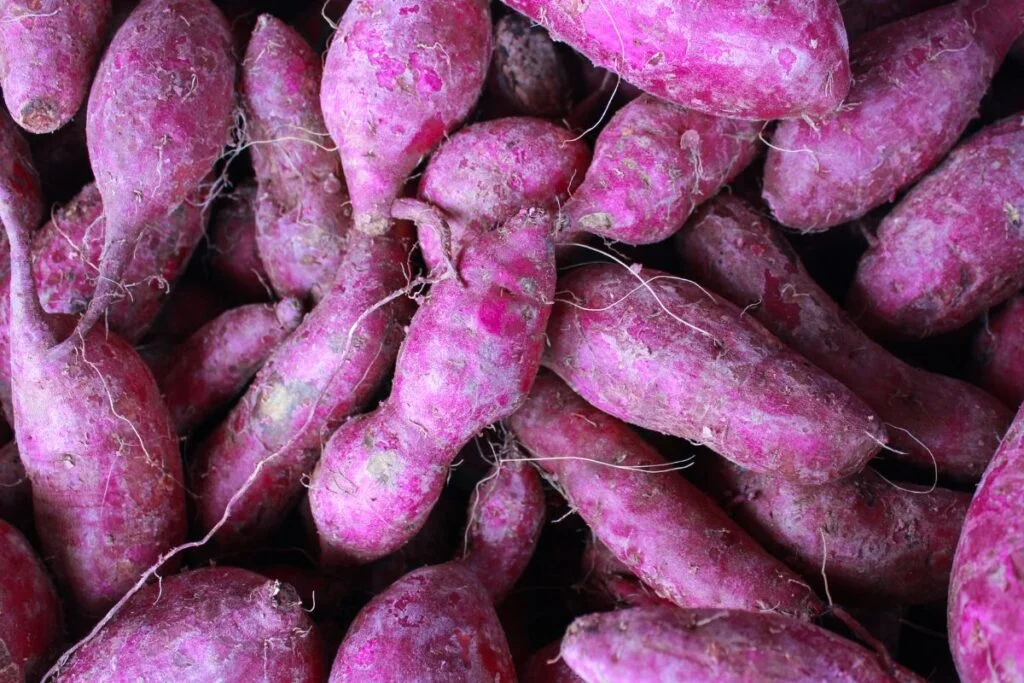
When to Harvest
Determining the readiness of sweet potatoes for harvest involves observing the vines' condition. Once the vines start to yellow and wither, it's a sign that the sweet potatoes are reaching maturity. the size of the tubers beneath the soil is an indicator of when they are ready to be harvested.
Harvesting sweet potatoes at the optimal timing ensures that they have developed their full flavor and sweetness. Typically, sweet potatoes are ready for harvest between 90 to 170 days after planting, depending on the variety. The best time to harvest them is before the first frost in late fall.
Assessing the maturity of sweet potato tubers involves gently digging around the base of a plant to check the size and color of the tubers. Mature tubers will have a firm skin and reach their maximum size, indicating readiness for harvesting.
Harvesting Techniques
Proper techniques for harvesting sweet potatoes involve gently loosening the soil around the plants using a fork or spade. Carefully lift the tubers out of the ground by hand to avoid damaging them during harvest.
To harvest sweet potatoes successfully, follow these step-by-step instructions:
- Start by cutting back the foliage a few weeks before harvesting.
- Use a garden fork or shovel to dig around each plant carefully.
- Lift out each plant gently, ensuring not to bruise or damage the tubers.
- Brush off excess soil from the tubers without washing them.
During the harvesting process, it's crucial to handle sweet potatoes with care to prevent bruising or cuts on their skin. Rough handling can lead to spoilage during storage, affecting their quality and shelf life.
Curing and Storage
Curing Process
After harvesting purple sweet potatoes, it's crucial to cure them properly. Curing enhances the flavor and extends the storage life of sweet potatoes. To cure, place the harvested potatoes in a warm and humid environment for about 10-14 days. This process allows the skin to mature, healing minor cuts, and thickening the skin for better storage.
Curing is essential as it improves the taste by converting starches into sugars, resulting in a sweeter flavor. Moreover, it helps heal any damage from harvesting, reducing the risk of rot during storage. The curing duration may vary but typically lasts between 1-2 weeks. Ensure the curing area maintains a temperature of around 80-85°F with high humidity levels.
Storing Properly
For optimal storage of purple sweet potatoes, follow these best practices. Store them in a cool, dark place with good ventilation to prevent sprouting or molding. Avoid refrigeration as it can negatively impact their taste and texture. To prolong shelf life, keep sweet potatoes away from moisture and direct sunlight.
To maintain quality, store sweet potatoes in a well-ventilated area at temperatures between 55-60°F. A basement or pantry works well for this purpose. Ensure proper air circulation to prevent moisture build-up that can lead to spoilage. By following these guidelines, you can enjoy fresh and flavorful sweet potatoes for an extended period.
Cooking and Recipes
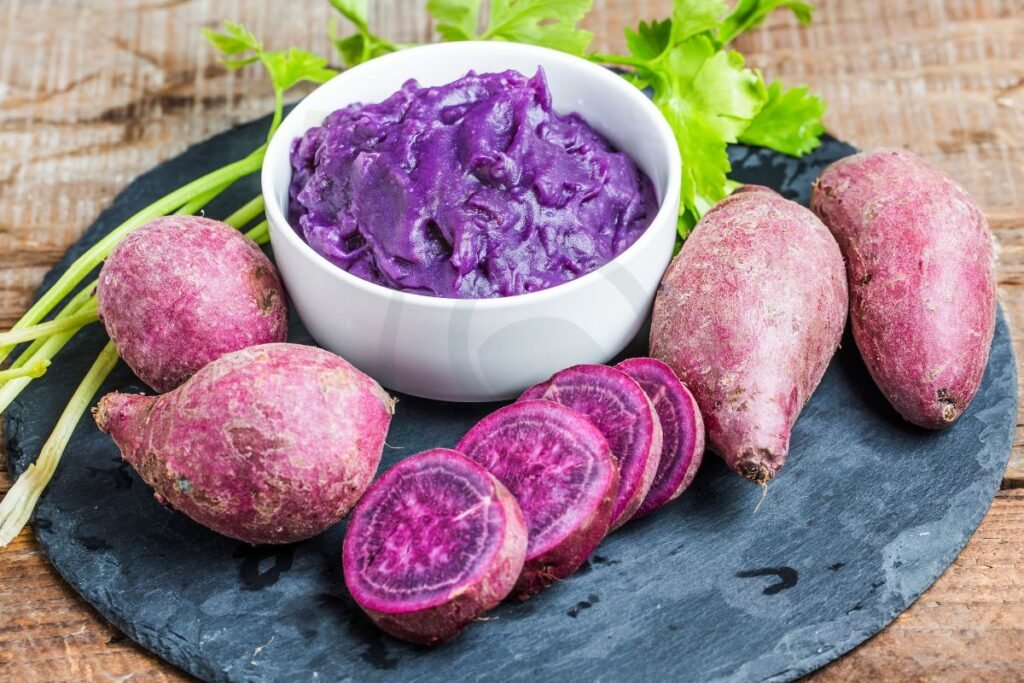
Cooking Tips
People often underestimate the versatility of purple sweet potatoes in cooking. To prepare Okinawan Sweet Potatoes, start by baking them for a nutrient-rich meal. For a crispy texture, try roasting thin slices of these sweet potatoes with olive oil.
Incorporate purple sweet potatoes into your meals by making mashed purple sweet potatoes as a side dish or adding them to soups for added flavor and color. These sweet potatoes can also be used to make healthy and vibrant salads.
Recipe Ideas
Experiment with various recipe ideas using Okinawan Sweet Potatoes to add a unique twist to your meals. Create purple sweet potato fries as a flavorful and colorful snack option. Another creative idea is to make purple sweet potato gnocchi for a delicious and visually appealing dish.
For a sweet treat, try baking purple sweet potato pie or making purple sweet potato pancakes for breakfast. These recipes showcase the diversity of purple sweet potatoes in both savory and sweet dishes.
Summary
After learning about purple sweet potatoes, preparing for planting, creating DIY potato slips, understanding the planting process, caring for plants, harvesting, curing, and even cooking these delightful tubers, you are now equipped with the knowledge to cultivate your own vibrant harvest. By following these steps diligently, you can enjoy the satisfaction of growing your purple sweet potatoes and relishing their delicious flavors in various recipes. Take this opportunity to embark on a rewarding journey of gardening and culinary exploration with purple sweet potatoes as your star ingredient. Share your experiences with others and inspire them to join you in this flavorful adventure.
Frequently Asked Questions
How do I understand the benefits of purple sweet potatoes?
Purple sweet potatoes are rich in antioxidants, fiber, vitamins, and minerals. They offer potential health benefits such as improved digestion, better blood sugar control, and enhanced immunity.
Can I plant purple sweet potatoes in containers?
Yes, you can grow purple sweet potatoes in containers. Choose a container at least 20 inches deep with good drainage to ensure healthy growth.
What is the best time to harvest purple sweet potatoes?
Harvest your purple sweet potatoes about 3-4 months after planting. Wait until the vines have started to yellow and die back before harvesting for optimal flavor.
How should I store harvested purple sweet potatoes?
Store harvested purple sweet potatoes in a cool, dry place away from sunlight. Proper storage conditions can help extend their shelf life and maintain their quality.
Are there any unique cooking recipes for purple sweet potatoes?
You can try various cooking methods like roasting, mashing, or baking purple sweet potatoes. Experiment with recipes like Purple Sweet Potato Casserole or Purple Sweet Potato Fries for delicious meals.
Image Source: Paid image from CANVA

